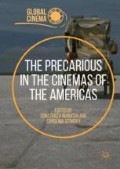Abstract
Since the triumph of the Revolution, Cuban film has held an official role in constructing, reflecting, and criticizing the national project through the established state filmmaking institute: the ICAIC. Despite the assumed monopoly of the Havana-based ICAIC and the reduced vision of revolutionary Cuba, the film landscape has proven much more complex within and beyond the state. In order to explore those who have worked to negotiate a space in Cuba’s centralized film landscape, this chapter analyzes a rural documentary producer, Televisión Serrana, and one filmmaker in particular, Ariagna Fajardo. Far from the institutional hub of Havana, hovering between a local and national partnership, Televisión Serrana makes visible life from the Sierra Maestra while also serving as an educational platform to transfer the filmmaking process to the local community. Having grown up in the Televisión Serrana’s community educational program, and now as one its most awarded directors, Fajardo captures this mission in her film ¿A dónde vamos?, which explores the precarious farming realities that have caused many of her young peers to abandon rural life to live in an illegal limbo in urban centers. Her film has resulted in national attention to the issue of fair prices and food distribution for rural farmers. Beyond the content of the film however, Fajardo’s many works face a similar challenge in terms of distribution and exhibition as the ageing legal state-film mechanisms do not reflect the changing audiovisual landscape of contemporary Cuban film.
Travel and field research for this chapter were made possible with the generous support of both the American Philosophical Society’s Franklin Research Grant and Fairfield University’s Humanities Institute Grant.
Access this chapter
Tax calculation will be finalised at checkout
Purchases are for personal use only
Works Cited
Altieri, Miguel A., and Fernando R. Funes-Monzote. “The Paradox of Cuban Agriculture.” Monthly Review 63, no. 8 (2012): 23–33.
Benamou, Catherine. “Cuban Cinema: On the Threshold of Gender.” Frontiers: A Journal of Women Studies 15, no. 1, Women Filmmakers and the Politics of Gender in Third Cinema (1994): 51–75.
Burton, Julianne. The Social Documentary in Latin America. Pittsburgh: University of Pittsburgh Press, 1990.
Chanan, Michael. Cuban Cinema. Minneapolis: University of Minnesota Press, 2004.
Cortázar, Octavio. El Brigadista. Havana: ICAIC, 1977.
Cortázar, Octavio. Por primera vez. Havana: ICAIC, 1968. “Conceptualización del modelo económico y social cubano de desarrollo socialista plan nacional de desarrollo económico y social hasta 2030: Propuesta de Visión de La Nación, ejes y sectores estratégicos.” Granma, May 24, 2016. Accessed May 24, 2016. http://www.granma.cu/file/pdf/gaceta/Copia%20para%20el%20Sitio%20Web.pdf.
Díaz Torres, Daniel. Alicia en el pueblo de Maravillas. Havana: ICAIC, 1991.
Diéguez, Danae. “¿Ellas miran diferente? Temas y representaciones de las reali-zadoras jóvenes en Cuba.” Cinémas d’Amérique Latine 20 (2012): 150–162.
Diéguez, Danae. “Otras islas: las realizadoras jóvenes en Cuba.” La Jiribilla: Revista de Cultura Cubana 10 May (2014). Accessed June 14, 2016. epoca2.lajiribilla.cu/articulo/7516/otras-islas-las-realizadoras-jovenes-en-cuba.
“Directores protestan por demora de ley de cine en Cuba.” La Jornada: En línea, June 1, 2015. Accessed June 3, 2015. www.jornada.unam.mx/ultimas/2015/06/01/directores-padecen-demora-de-ley-de-cine-en-cuba-9354.html.
Fajardo, Ariagna. La Vuelta. San Pablo de Yao: Televisión Serrana, 2008.
Fajardo, Ariagna. ¿A dónde vamos? San Pablo de Yao: Televisión Serrana, 2009.
Fajardo, Ariagna. Como un rayo de luz. San Pablo de Yao: Televisión Serrana, 2009.
Fajardo, Ariagna. El Círculo. San Pablo de Yao: Televisión Serrana, 2011.
Fajardo, Ariagna. Papalote. San Pablo de Yao: Televisión Serrana, 2011.
Fajardo, Ariagna. Al Sur…el mar. San Pablo de Yao: Televisión Serrana, 2012.
Fajardo, Ariagna. Guárdame el tiempo. San Pablo de Yao: Televisión Serrana, 2013.
Fajardo, Ariagna. Interview by author. Tape recording. Televisión Serrana, San Pablo de Yao, Cuba, July 11, 2016.
Fajardo, Ariagna. Mi herencia. San Pablo de Yao: Televisión Serrana, 2016.
Fernandes, Sujatha, and Alexandra Halkin. “Stories that Resonate: New Cultures of Documentary Filmmaking in Cuba.” LASA Forum XLV, no. 2 (Spring 2014): 20–22.
Gómez, Sara. De cierta manera. Havana: ICAIC, 1974.
Jiménez-Leal, Orlando. El Caso pM: Cine, Poder y Censura. Madrid: Editorial Colibrí, 2012.
King, John. Magical Reels: A History of Cinema in Latin America. London: Verso, 1990.
Korte, Barbara, and Frédéric Regard. Narrating “Precariousness”: Modes, Media, Ethics. Heidelberg: Universitätsverlag Winter, 2014.
Salazar, María Elvira. “Noche de documentales: ¿A dónde vamos? y Papalotes.” María Elvira Salazar Show. December 31, 2013. YouTube video published “María Elvira Salazar,” December 31, 2013. https://www.youtube.com/watch?v=tNgAnxGV2Qo.
Schroeder, Paul A. Latin American Cinema: A Comparative History. Oakland, CA: University of California Press, 2016.
Stock, Ann Marie. On Location in Cuba: Street Filmmaking During Times of Transition. Chapel Hill: University of North Carolina Press, 2009.
Author information
Authors and Affiliations
Editor information
Editors and Affiliations
Rights and permissions
Copyright information
© 2018 The Author(s)
About this chapter
Cite this chapter
Farrell, M.L. (2018). Narrating Precariousness in Cuba Beyond Havana and the ICAIC: The Case of Televisión Serrana’s Ariagna Fajardo and ¿A dónde vamos?. In: Burucúa, C., Sitnisky, C. (eds) The Precarious in the Cinemas of the Americas. Global Cinema. Palgrave Macmillan, Cham. https://doi.org/10.1007/978-3-319-76807-6_6
Download citation
DOI: https://doi.org/10.1007/978-3-319-76807-6_6
Published:
Publisher Name: Palgrave Macmillan, Cham
Print ISBN: 978-3-319-76806-9
Online ISBN: 978-3-319-76807-6
eBook Packages: Literature, Cultural and Media StudiesLiterature, Cultural and Media Studies (R0)

